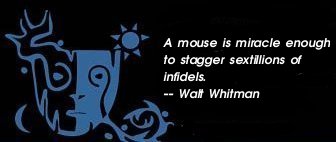
New Blank Documents
by Creative Director, Honora Foah

They say the souls of all those to be born in the coming year gather around close to the earth throughout Advent.
Coming after the harvest of souls at All Souls, and in anticipation for the death and rebirth of the solstice light, I love this
picture of readiness and fresh spirit looking for its home of flesh.

All of us born at once at the solstice.
What I like to do at this time of year is music. The birth of everything needs to start with music. And at this season,
there are more concerts suitable for being born. When my son was an infant, if I ran out of songs to sing, no matter what
time of year it was, I sang Christmas carols because when I sang, or we listened to music in a minor key, he used to furrow
up his little face into an expression of agony. One time a friend witnessed this as we listened to Schumann, and was so
shocked by the baby's face, that he jumped up and snapped off the radio.
But Christmas music is in a major key because sometimes we need unadorned hope, un-nuanced, unambiguous,
unlikely hope in the new birth.
Another time, I was living in a little room in a community for retarded adults with whom I was working.
My small son, 3 years old, was with me there. When it came time to celebrate Chanukah, we didn't have a menorah,
but the community made exquisite beeswax candles. I found cups and things to put eight candles in and we lit one
and then two and then three in our dark room on a dark farm. The increase of the light, the difference between the
first night and the eighth, was an extraordinary experience for someone who grew up with electric light. Zachariah and
I just sat and watched the candles burn until they were out. He would fall asleep. Then I would watch him along with
the flames.

All the solstice celebrations are prayers for the increase of the light. Reverence, fear, hope for the return of the sun.
We humans are so precariously balanced upon a very small point of possibility held in place by an exact relation to the good
graces of the Sun. This god holds all life in his hands. If he turned his back displeased, our goose would be cooked, or raw,
or no goose at all on the Christmas table.
So he turns his face back to us and we see the promise of a child. And a promise is all it is, because the days are so cold
and will only get colder for at least a month or two. We light a fire, we sing, we drink. Yuletide. We keep these rituals more
than most others. Why is that?
"A ritual is an enactment of a myth," Joseph Campbell says. The myth of the winter is the child-face of light. We live in a
moment, we live in a culture whose way of life is unsustainable. We cannot go on like this. We are out of balance; our
relationship to the sun has become troubled. That is what global warming is. Our exact perfect atmosphere is damaged
and the tolerances for error are very small. A few degrees.
Looking into the face of the child, looking into the face of our children, looking into the face of the sun, looking into the
face of the future, looking into the fear of the sun, we might engage the profound level of feeling that our ancestors gave voice
to when they created these winter rituals which we still enact. The rituals recognize where the power lies. The rituals recognize
fear and hope and the human obligation to be in right relationship to the sun, the moon, the ground.
If we want the child to reappear, we must keep vigil all night, invoke the relationship, remember our place, re-live the
meaning of the story.
"Myth is an attempt to narrate a whole human experience, of which the purpose is too deep, going too deep in the
blood and soul, for mental explanation or description." — DH Lawrence
Return to Passages Menu
Subscribe to the Passages e-newsletter
|

